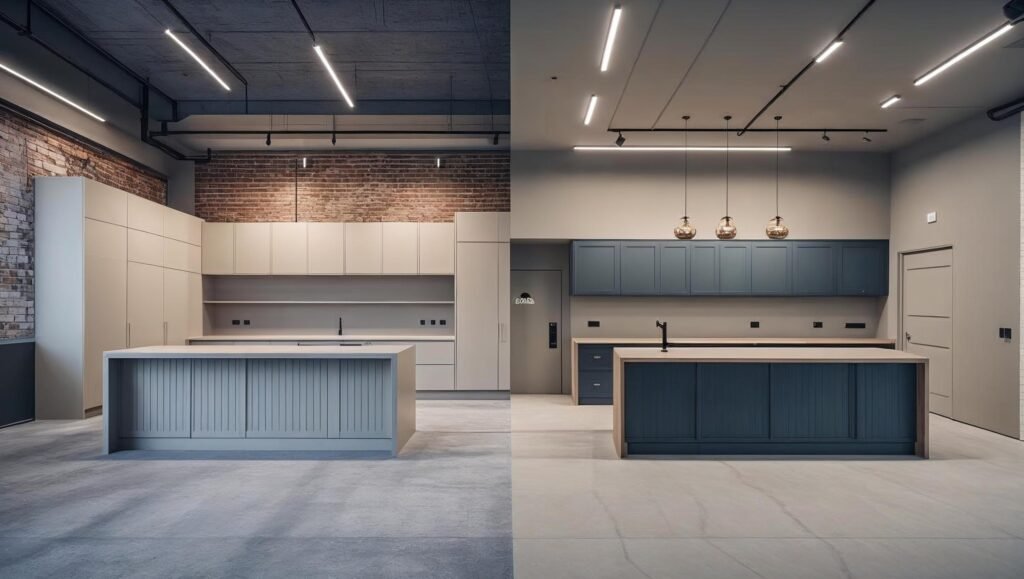What’s the Difference?
When leasing commercial office space in the UK, understanding the difference between CAT A and CAT B fit out is essential for businesses, tenants, and landlords. Choosing the right office design, especially a CAT B fit out, can make all the difference in terms of cost, functionality, and branding. In this guide, we’ll break down what CAT A and a CAT B fit out are, helping you make informed decisions for your business’s needs.
What is a Shell and Core Fit-Out
Before diving into CAT A and CAT B, it’s important to understand the shell and core phase, which forms the foundation of any commercial space.
Shell and Core: This stage covers the structural elements like external walls, roof, windows, and doors, leaving tenant spaces unfinished and ready for further development.
The common areas (such as lobbies and stairwells) are typically completed, but tenant spaces often remain as empty concrete shells with no furnishings or systems in place.
What is a CAT A Fit-Out?
A CAT A fit-out transforms the basic shell and core structure into a neutral, functional workspace. This stage sets the foundation for customization, offering a blank canvas that tenants can personalize.
Key Features of CAT A Fit-Out:
- Suspended ceilings and raised floors for easy cable management
- Basic lighting and HVAC systems (heating, ventilation, and air conditioning)
- Fire detection and alarm systems
- Electrical distribution boards and basic plumbing connections
Who is Responsible?
Landlords generally fund and deliver CAT A fit-outs, making the space ready for tenants to customize. This process ensures compliance with building regulations and makes the property marketable.
What is a CAT B Fit-Out
A CAT B fit-out is all about personalization. Once the foundation is set with CAT A, tenants can fully customize the space to reflect their brand identity and meet operational needs.
Key Features of CAT B Fit-Out:
- Partitioning to create individual workstations, meeting rooms, and collaboration zones
- IT infrastructure for networking and communications, including AV setups (video conferencing, etc.)
- Furniture, branding elements, and decorative finishes that reflect the company’s identity
- Specialized systems, such as security or health and safety features, depending on the tenant’s needs
Who is Responsible?
In most cases, tenants fund and manage the CAT B fit-out process. Some landlords may offer incentives (e.g., rent-free periods) to help with the upfront costs, especially for long-term leases. Learn more about how to negotiate tenant fit-out incentives.
What is CAT A+ Fit-Out?
CAT A+ is a hybrid option that falls between CAT A and CAT B. It offers a move-in ready solution with some customized features but lacks extensive branding or design. This is ideal for tenants seeking flexibility and quick occupancy without major customization.
Key Features of CAT A+:
- Basic furniture and partitioning for a functional setup
- Minimal design and branding for businesses that need immediate use without heavy customization
This option is perfect for businesses seeking flexible workspaces and quick transitions. For more on quick office solutions, check out our guide on finding flexible office spaces.
Key Differences Between CAT A and CAT B Fit-Outs
| Aspect | CAT A Fit-Out | CAT B Fit-Out |
|---|---|---|
| Customization | Basic setup with infrastructure | Fully personalized to tenant’s specific needs |
| Cost | Lower upfront cost, but requires further tenant investment | Higher upfront cost but ready for immediate use |
| Responsibility | Typically funded by landlords | Typically funded by tenants |
| Timeline | Shorter completion time | Takes longer due to detailed customization |
When to Choose a CAT A Fit-Out?
CAT A fit-outs are ideal if:
- You’re a landlord looking to offer a flexible, neutral space for tenants.
- Your business requires a blank canvas with essential systems like HVAC, lighting, and basic plumbing.
- You want to customize the space yourself or have short-term lease agreements where long-term personalization isn’t necessary.
For more information on customizing your commercial space, check out our latest blog.
When to Choose a CAT B Fit-Out
CAT B fit-outs are perfect if:
- You need a fully customized workspace that aligns with your brand identity and company culture.
- Your business requires specialized IT systems, partitions, or other personalized features to create an efficient work environment.
- You’re a tenant who wants to create a space that’s ready for immediate use.
Cost and Time Considerations: CAT A vs CAT B
- CAT A Fit-Out: Lower initial investment and a shorter completion time. However, additional customization costs will be incurred to make the space fully functional for your business.
- CAT B Fit-Out: Higher upfront costs due to the extent of customization. This process takes longer, but it delivers a fully personalized space that’s ready for immediate use.
Tip: Combining CAT A and CAT B into one seamless process can save costs and time by eliminating redundant work.
Conclusion: Choosing the Right Fit-Out for Your Business
The choice between CAT A and CAT B fit-outs depends on your business’s specific needs, timeline, and budget.
Key Takeaways:
- CAT A is ideal for landlords and businesses seeking flexibility and a neutral base for customization.
- CAT B provides a fully tailored environment for businesses with specific operational requirements.
- CAT A+ offers a quicker solution for those who need move-in ready spaces with minimal work.
Need Help with Your Fit-Out?
If you’re looking for a customized office space or a retail fit-out in London, Manchester, or anywhere across the UK, Najm Interiors can guide you through every step of the process. Get in touch with us today!
FAQs
Q1: What’s the main difference between CAT A and CAT B fit-outs?
A1: CAT A provides the basic infrastructure for a functional workspace, while CAT B offers full customization tailored to the tenant’s needs, including branding and specific systems.
Q2: Who funds the fit-out?
A2: Landlords typically fund CAT A fit-outs, while tenants are responsible for the cost of the CAT B fit-out. However, landlords may offer incentives in some cases.
Q3: How do costs and timelines compare?
A3: CAT A fit-outs are more economical and faster to complete, but CAT B fit-outs involve higher upfront costs and more time for customization.
Q4: What is CAT A+?
A4: CAT A+ is a hybrid solution that combines features of both CAT A and CAT B. It provides a move-in ready space with some personalization but without the full branding and extensive customization.

